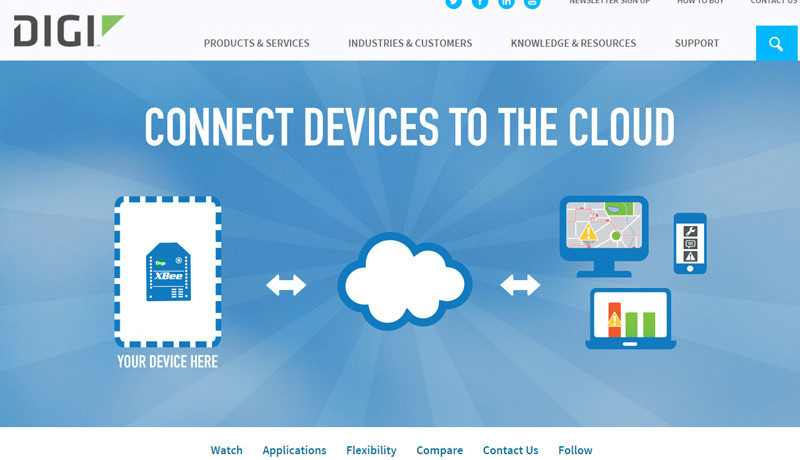My Journey into the Cloud (1)
December 26, 2015
on
on

Perhaps you’ve noticed, like me, that it’s almost impossible these days to avoid the ‘Internet of Things’. Amid the tsunami of information it’s sometimes difficult to get an overview of the technology. In this case it’s partly due to the nature of the beast; it’s not so easy to grasp what’s going on in networked systems compared to a simple stand-alone project where you can see everything and it all takes place on a single board. On the other hand there are many ways to transfer data from a sensor to where it is displayed or used in an application running on a target device. It all starts at the lowest protocol layer where a variety of wireless standards compete with wired communication such as Ethernet.
I turned to the Internet for more information. There are various types of Cloud-Services, available. In general ‘The Cloud’ can be thought of as an area in the Internet where, from outside, it is no longer possible to identify where individual user data is located. Any user supplying data to the Cloud won’t know exactly where it ends up; it’s all a bit, well… cloudy. Many companies already rent out Cloud storage but memory space is not all that’s on offer. It’s possible to run a program in the Cloud (Software as a Service) where the complete application is delivered to the end user, response times don’t seem to be a lot different to systems installed locally. It also provides a platform (Platform as a Service) where Web applications can be developed, run and managed without the need for local installation and infrastructure maintenance for app development and launching. Cloud service providers such as Amazon Web Services have expanded the basic services, in response to the needs of the IoT sector. ‘Devices’, for example, equipped with sensors can store measurement values to a Cloud database, to be retrieved later by the user via a smartphone or computer. The big advantage of this configuration is that the sensor board does not need to maintain a local link to a smartphone running an associated app. It offers significant power saving by allowing the sensor board to shut down completely between measurements.
The facility is a logical step for Amazon: Databases for information storage are already well established together with some essential software components which can be reused and a lot of experience has already been gained. A similar mix of services is provided by some of the smaller IoT start-ups such as Relayr (‘WunderBar’). Hardware-developers such as Digi (‘XBee’) and ARM are also offering Cloud-based services. When you take a closer look you see many common features such as the use of HTTP and MQTT data transport layer protocols. We will take a closer look at this in the next article!
I turned to the Internet for more information. There are various types of Cloud-Services, available. In general ‘The Cloud’ can be thought of as an area in the Internet where, from outside, it is no longer possible to identify where individual user data is located. Any user supplying data to the Cloud won’t know exactly where it ends up; it’s all a bit, well… cloudy. Many companies already rent out Cloud storage but memory space is not all that’s on offer. It’s possible to run a program in the Cloud (Software as a Service) where the complete application is delivered to the end user, response times don’t seem to be a lot different to systems installed locally. It also provides a platform (Platform as a Service) where Web applications can be developed, run and managed without the need for local installation and infrastructure maintenance for app development and launching. Cloud service providers such as Amazon Web Services have expanded the basic services, in response to the needs of the IoT sector. ‘Devices’, for example, equipped with sensors can store measurement values to a Cloud database, to be retrieved later by the user via a smartphone or computer. The big advantage of this configuration is that the sensor board does not need to maintain a local link to a smartphone running an associated app. It offers significant power saving by allowing the sensor board to shut down completely between measurements.
Subscribe
Tag alert: Subscribe to the tag Journey into the Cloud - Article series and you will receive an e-mail as soon as a new item about it is published on our website! The facility is a logical step for Amazon: Databases for information storage are already well established together with some essential software components which can be reused and a lot of experience has already been gained. A similar mix of services is provided by some of the smaller IoT start-ups such as Relayr (‘WunderBar’). Hardware-developers such as Digi (‘XBee’) and ARM are also offering Cloud-based services. When you take a closer look you see many common features such as the use of HTTP and MQTT data transport layer protocols. We will take a closer look at this in the next article!
Read full article
Hide full article


Discussion (0 comments)